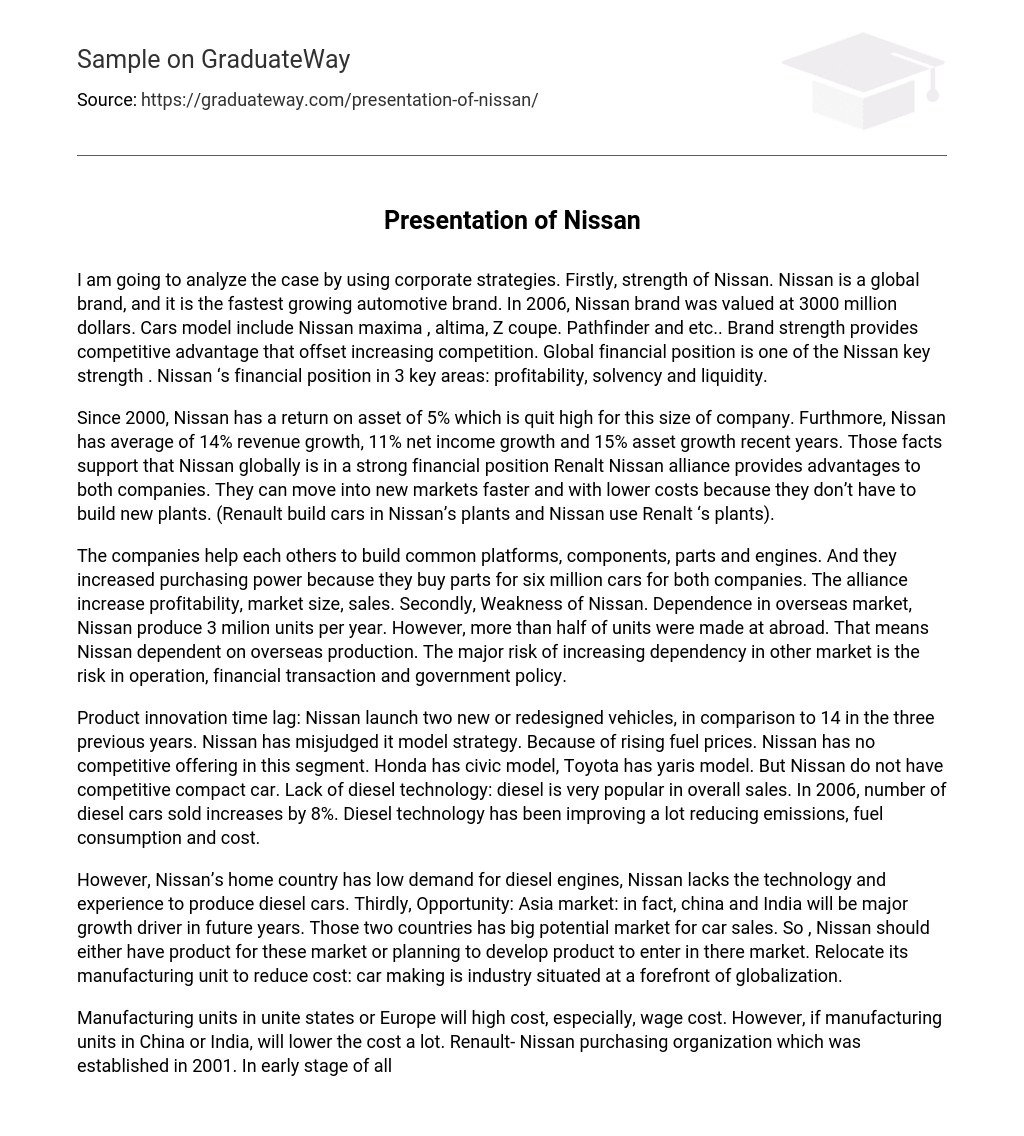I am going to analyze the case by using corporate strategies. Firstly, strength of Nissan. Nissan is a global brand, and it is the fastest growing automotive brand. In 2006, Nissan brand was valued at 3000 million dollars. Cars model include Nissan maxima , altima, Z coupe. Pathfinder and etc.. Brand strength provides competitive advantage that offset increasing competition. Global financial position is one of the Nissan key strength . Nissan ‘s financial position in 3 key areas: profitability, solvency and liquidity.
Since 2000, Nissan has a return on asset of 5% which is quit high for this size of company. Furthmore, Nissan has average of 14% revenue growth, 11% net income growth and 15% asset growth recent years. Those facts support that Nissan globally is in a strong financial position Renalt Nissan alliance provides advantages to both companies. They can move into new markets faster and with lower costs because they don’t have to build new plants. (Renault build cars in Nissan’s plants and Nissan use Renalt ‘s plants).
The companies help each others to build common platforms, components, parts and engines. And they increased purchasing power because they buy parts for six million cars for both companies. The alliance increase profitability, market size, sales. Secondly, Weakness of Nissan. Dependence in overseas market, Nissan produce 3 milion units per year. However, more than half of units were made at abroad. That means Nissan dependent on overseas production. The major risk of increasing dependency in other market is the risk in operation, financial transaction and government policy.
Product innovation time lag: Nissan launch two new or redesigned vehicles, in comparison to 14 in the three previous years. Nissan has misjudged it model strategy. Because of rising fuel prices. Nissan has no competitive offering in this segment. Honda has civic model, Toyota has yaris model. But Nissan do not have competitive compact car. Lack of diesel technology: diesel is very popular in overall sales. In 2006, number of diesel cars sold increases by 8%. Diesel technology has been improving a lot reducing emissions, fuel consumption and cost.
However, Nissan’s home country has low demand for diesel engines, Nissan lacks the technology and experience to produce diesel cars. Thirdly, Opportunity: Asia market: in fact, china and India will be major growth driver in future years. Those two countries has big potential market for car sales. So , Nissan should either have product for these market or planning to develop product to enter in there market. Relocate its manufacturing unit to reduce cost: car making is industry situated at a forefront of globalization.
Manufacturing units in unite states or Europe will high cost, especially, wage cost. However, if manufacturing units in China or India, will lower the cost a lot. Renault- Nissan purchasing organization which was established in 2001. In early stage of alliance, the one of key way is to combine their resources to create more efficient organization. Currently Nissan and Renault share 60% same part and raw material suppliers. This led Nissan to achieve greater purchasing power and reduce costs. This will increase competitive advantage.
At last, Threats of Nissan: Cross-culture Disharmony: as Nissan and Renault become further integrated, the risk of cross culture disharmony increase. If disharmony occurs, overall company performance will be reduced and current strength that alliance provides will become instabilities. . Rising commodity price: due to economic expansion of china, changes in commodity price could affect the costs for Nissan. Over the past 12 months, the price of steel used in car production has risen by 30%. Nissan has taken steps to reduce the effect of rising steel prices.
Market saturation: due to overall market saturation, the individual company new product development strategy towards market expansion is changing from year on year model changes to innovation Growth objectives of Nissan: There are three objectives. First one is efficient global production. Nissan has to minimum investment, easy to produce anywhere and optimum utilization ratio. Second aim is all-out waste elimination. To fulfill this objective. Nissan need to minimum inventory, further improvement in quality and overall equipment efficiency.
The third objective is plant competitiveness improvement. Two issues are friendly competition between palnts and effective information sharing. This diagrams shows global strategies of Nissan: geographic expansion: Russia, India ,china RNPO is Renault Nissan purchasing organization. Which established in 2001, combine their resources to create more efficient organization . Global production preparation activity: it include 4g strategies : global training center, global production training center, global package design center and global launching expert.





